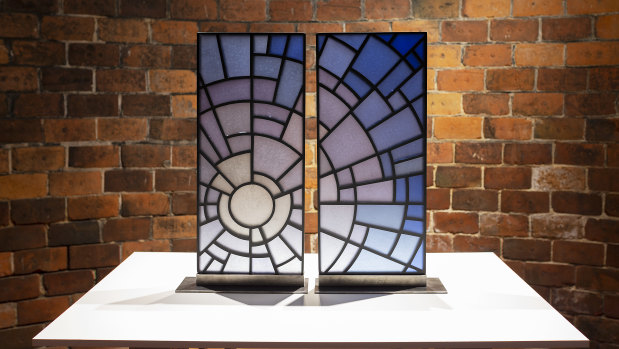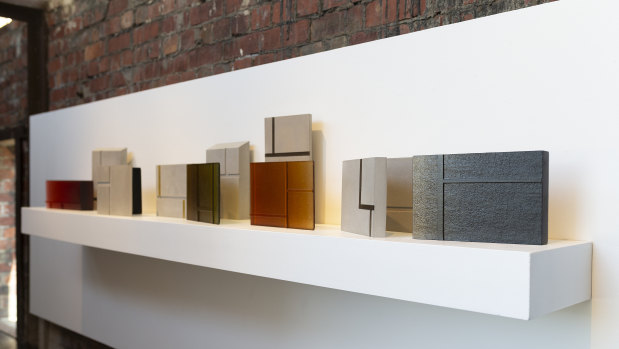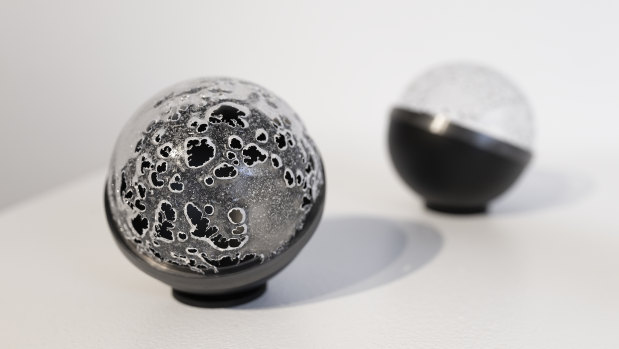By Kerry-Anne Cousins
Illuminated Spaces. Glass by Lisa Cahill, Scott Chaseling. Judi Elliott, Jeremy Lepisto, Ruth Oliphant, Lucy Palmer, Clare Peters, Kirstie Rea and Richard Whiteley. Canberra Glassworks. Until 23 December.

Ruth Oliphant, 'Rise', 2013, fused glass and steel.
The exhibition Illuminated Spaces, curated by Dr. Grace Blakeley-Carroll, investigates artists `whose work is informed by the tradition of architectural glass art including stained glass’.
Indeed one of the surprises of this exhibition is how many well-known artists studied stained glass before moving into other fields of glassmaking. Stained glass is about colour and light and it is these factors that have drawn so many artists to the medium of glass. Lisa Cahill, Scott Chaseling, Judi Elliott, Jeremy Lepisto, Ruth Oliphant, Lucy Palmer, Clare Peters, Kirstie Rea and Richard Whiteley are all artists whose glass practice features some connection with architecture through strong structural design informed by light and colour.
To the medieval mind, the manner in which stained glass in places of worship allowed light to penetrate architectural space gave material expression to the mystical aspect of God as being the light that shines in the darkness.
Clare Peters in her two series of works Place of Promise, Place of Shelter, Place of Rest and Hope Held i-v celebrates this ecclesiastical aspect of light by including illuminated scriptural texts into her glass constructions. The dark glass forms of her rondels and small globes remind me of the art of scrying or crystal gazing. Clare Peters’ small globes offer not a glimpse of the past but a `handheld’ promise of hope for the future.

Lucy Palmer and Kirstie Rea, 'Untitled', 2018, glass and concrete.
Ruth Oliphant came to studio glass through studying traditional stained glass. Her work uses the motif of architectural imagery in a metaphorical way: as the framework for the allegory of herself looking within (retrospection) and looking out (into the world). In Illuminated Spaces, Oli[phant's work reflects her interest in the appearance of stained glass in two glass panels - Rise (2013 design-infused glass and steel based on a design of the rising sun) and Untitled from 2004. This latter work in leadlight is a graceful design based on gently curving shapes and contrasting textures of clear glass.
Judi Elliot’s glass practice has been inspired by her interest in domestic architecture. She states that she reveres the domestic setting and its ability to embed within its walls the stories of previous occupants. However, Elliot's large work Architecture in the Environment (61cm x 61cm) looks beyond the intimacy of the domestic setting to create a compelling free-standing sculpture of two facing shards. Its bright colours of yellows and reds, characteristic of Elliott’s work, testifies to her innate sense of colour and design. In spite of only being 51cm in height, the work is monumental in concept and would work aesthetically as sculpture in an architectural setting.
Jeremy Lepisto’s work Structure 2 demonstrates the artist’s continuing interest in structural design. Lepisto has found his own individual voice by looking for inspiration in factory sites and warehouses. His imagery is taken from the urban landscape that most of us inhabit but do not really notice.

Clare Peters, 'Hope, Held I, II, III, IV and V', 2018, kiln formed pate de verre, powder coated steel, leaded and soldered construction.
Kirstie Rea feels more at ease outdoors than in the confinement of architectural spaces. Intriguingly however, some of her works exhibited recently have reflected the outdoors mirrored in the windows and doors of a domestic interior. In a collaborative work with Lucy Palmer - Untitled - small building blocks of grey concrete are interspersed with other blocks of coloured glass mirroring the way light and colour is used to enliven and illuminate architectural buildings.
One of Lisa Cahill’s beautiful wall pieces Breathe (2009) is installed to great effect in an architectural setting in inner Sydney (at 34 Castlereagh Street). In this narrow inner city entrance it succeeds in bringing colour and surface interest to animate an otherwise neutral space. Her works in this exhibition are constructed in a similar manner. Small glass panels arranged in rows make up larger panels of varying sizes. Visual interest is created through undulating surfaces so the works seem to flutter as if stirred by a breath of air.

Jeremy Lepisto, 'Structure 2' (from the Aspect Series), 2018, kiln formed glass and fabricated glass.
In addition to glass, Scott Chaseling works with contemporary materials of silicon, plastic and neon. He characterises his work as `attempting to create a liminal space between a sense of place and one of being lost’. Chaseling's Self-portrait: past and present is a neon sculpture - the present? - partnered with an attractive sculptural work of brightly coloured shapes. This latter work resembles a crochet patchwork rug and perhaps references the past and a sense of place?
Richard Whiteley’s sculptural work Absent Space is an ideal inclusion in this particular exhibition. His work draws attention to his continuing interest in constructing works in glass that use the vocabulary of architecture. The result, as in Absent Space, is a complex interplay of solids and voids creating spatial forms illuminated by light.